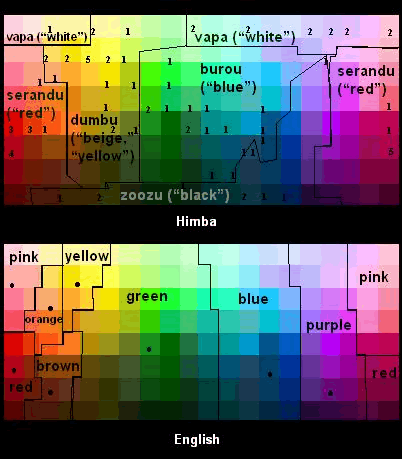Can You Describe Colour in Words?
Fields covered: Linguistics, Biology, Cognitive Science
Related Articles:
§ ![]() Color categories: Evidence for the cultural relativity hypothesis §
Color categories: Evidence for the cultural relativity hypothesis § ![]() Language and Color Perception: Evidence From Mongolian and Chinese Speakers §
Language and Color Perception: Evidence From Mongolian and Chinese Speakers § ![]() How to Explain Color to Someone Who Can’t See § How do Namibian Himbas see colour? § Language, thought, and reality: selected writings §
How to Explain Color to Someone Who Can’t See § How do Namibian Himbas see colour? § Language, thought, and reality: selected writings § ![]() Russian blues reveal effects of language on color discrimination |
Russian blues reveal effects of language on color discrimination |

Red. Green. Blue. How would you explain the meaning of these words to someone without sight? With no viable standard of comparison, the challenge appears daunting. Some have suggested comparing colours to emotions and feelings. Red – the warmth when standing under the sun; Green – the feeling of life when touching wet grass; Blue – the cooling sensation when taking a dip in the pool.
How would we distinguish close shades then? What about light green or dark brown? If red is warm and blue is cool, what does that make of purple? Differentiating close shades, which can already be difficult for us, would have a manifold difficulty for the visually impaired to comprehend.
We see colours when light reflects off an object and enters our eyes, where specialised cells known as cones convert light into signals that is sent to the brain. Certain people have missing or dysfunctional cones and are fully or partially incapable of recognising certain lights, colloquially known as “colour blindness”.
However, such biological differences may not be the sole factor affecting colour distinction. In fact, the potential role of language in influencing our visual perception has always been a topic of interest. Pioneering linguist Benjamin Whorf proposed the Sapir-Whorf hypothesis which states that our thoughts and cognition are shaped by our native language, thus speakers of different languages think of the world differently (Whorf, 1956).

After being screened for normal colour vision using standard tests for colour blindness, a study was conducted on monolingual speakers of Himba from a tribe in northern Namibia. The participants were shown twelve coloured tiles arranged in a circle and instructed to identify the differently coloured tile.
Interestingly, participants from the Himba tribe were quick to identify the unique tile in the first test on the left but it took them a longer period of time to identify the unique tile in the second test. This phenomenon could be attributed to the difference between the Himba and English language in distinguishing colours. The Himba language has more terms describing different shades of green, whereas blue and green are grouped together under the same term “buru” (Visagie, 2016).
The participants were also instructed to name the colours for a range of samples varying in hue, lightness, and saturation, with the image depicting the differences in categorisation between the languages (Roberson et al., 2005).
Similar independent studies were conducted by other researchers studying differences between Russian and English, and between Mongolian and Chinese (He et al., 2019; Winawer et al., 2007). These studies seem to suggest that our visual perception, at least with regards to colour distinction, is influenced by language, supporting the Sapir-Whorf hypothesis.
How then do we accurately communicate with regards to colours? Could the only solution lie in the complete overhaul of the naming system for RGB values? Or would such a miscommunication be too insignificant?





